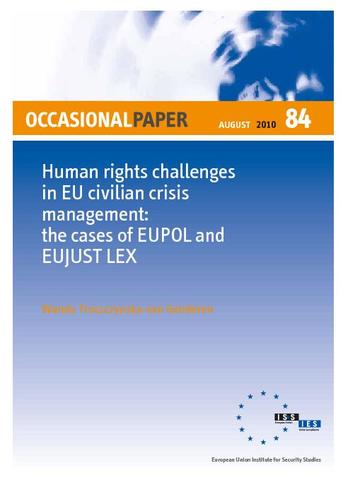You are here
Human rights challenges in EU civilian crisis management

Over the years, human rights have become an area of programmatic focus in international crisis management. The principle of human rights has come to be seen as not only having an intrinsic value in itself, but is also regarded as an important legitimising factor justifying international involvement in crisis situations throughout the world. This recognition of the importance of the human rights dimension has had serious implications for international crisis management efforts worldwide as it has become necessary to develop an appropriate methodology to integrate human rights ‘deliverables’ into all aspects of crisis management operations. At the same time, positive human rights obligations in international crisis response operations continue to primarily rest on ‘soft law’ instruments and customary ‘best practices’.
The geopolitical reality after the launch of the so-called ‘war on terror,’ which resulted in the two military interventions in response to which the missions analysed in this paper were set up, witnessed the emergence of new practical impediments to human rights implementation in civilian crisis response operations. The militarisation of the humanitarian space and blurred boundaries between military and civilian tasks resulted in the increased vulnerability of civilians working in ground operations. Simultaneously, the scale of human rights violations, coupled with security threats to civilians due to both attacks by insurgents and interventions carried out by international military personnel, created operational challenges going well beyond what previous CSDP civilian crisis management operations had to deal with.
This overall lack of security has technically obstructed the missions’ ability to carry out human rights-related aspects of the mandate, with concrete operational obstacles ranging from limited freedom of movement of mission staff members to inability to base mission members in a theatre, causing operations to be conducted remotely. This has given additional ammunition to critics who regard human rights as a ‘soft dimension’ of CSDP, with the argument advanced that a specific focus on human rights becomes a ‘distraction,’ ill-suited to implementation under extreme security-restricted conditions.
However, the Common Security and Defence Policy (CSDP) missions tend to operate in increasingly volatile and insecure theatres, where the sheer magnitude of human rights violations occurring poses the fundamental question of how to maximise the effective use of the usually modest human resources and logistical means available to address these issues.
Afghanistan and Iraq are currently considered among the two most challenging theatres for civilian crisis management operations. In this respect, the ongoing CSDP crisis management missions in these two countries – the European Union Police Mission in Afghanistan (EUPOL) and the European Union Integrated Rule of Law Mission to Iraq (EUJUST LEX) – constitute a yardstick for examining operational models chosen for high-risk CSDP civilian crisis management operations, and for assessing the degree to which these models are able to operationally integrate human rights dimensions.
The following analysis focuses on the main internal and external aspects of the missions’ human rights activities. Among the key internal human rights mission components, mission documents, staffing, available expertise, internal training, individual and institutional accountability mechanisms and overall mission transparency will be examined.
In terms of the external human rights profile of the missions’ activities, the analysis will focus on training programmes offered to local high-ranking officials from the police, the judiciary and the penitentiary services. The purpose is to examine how the missions include human rights issues in their external training curricula, how they ensure overall compliance with the human rights missions’ objectives and how they guarantee sustainability and local ownership. As the EUPOL and EUJUST LEX mandates, as well as the ways in which they carry out their operations, differ significantly, the training aspect has been chosen as a common denominator allowing for comparison.
In order to assess how well the missions reach out to the key international and local partners to enhance their own human rights focus, their collaboration with the United Nations counterparts (UNAMA and UNAMI human rights units) and local civil society actors will be briefly discussed. Last but not least, the missions’ human rights activities will be positioned within the broader institutional human rights landscape to signal how the EU country-specific financial and political instruments underpinning human rights protection and promotion complement the missions’ activities. While these factors do not sensu stricto constitute human rights ‘dimensions’ as such, they are among the key elements conducive to a better overall human rights environment.
The central question to be answered is whether the mission models adopted by EUPOL and EUJUST LEX can be considered as compliant with international best practices with regard to mainstreaming, protecting and promoting human rights in the context of civilian crisis response operations. Even though this paper does not assess per se the missions’ overall effectiveness, it evaluates their operational design, and the implication the chosen mission model has for the internal and external aspects of the missions’ human rights activities.
For the purpose of the following analysis, gender will be considered as a separate operational dimension for missions and is not included in the scope of the current research. In the context of CSDP crisis management operations, responsibilities for implementing human rights and gender objectives frequently fall on the same structures, even though gender mainstreaming has its own separate methodology and a corpus of key reference documents. While gender issues undoubtedly belong to a wider human rights category, their operationalisation, particularly in the context of inner-mission dimensions, requires a separate legal, conceptual and practical analysis, which merits separate research.